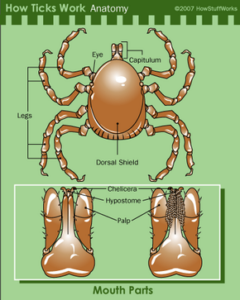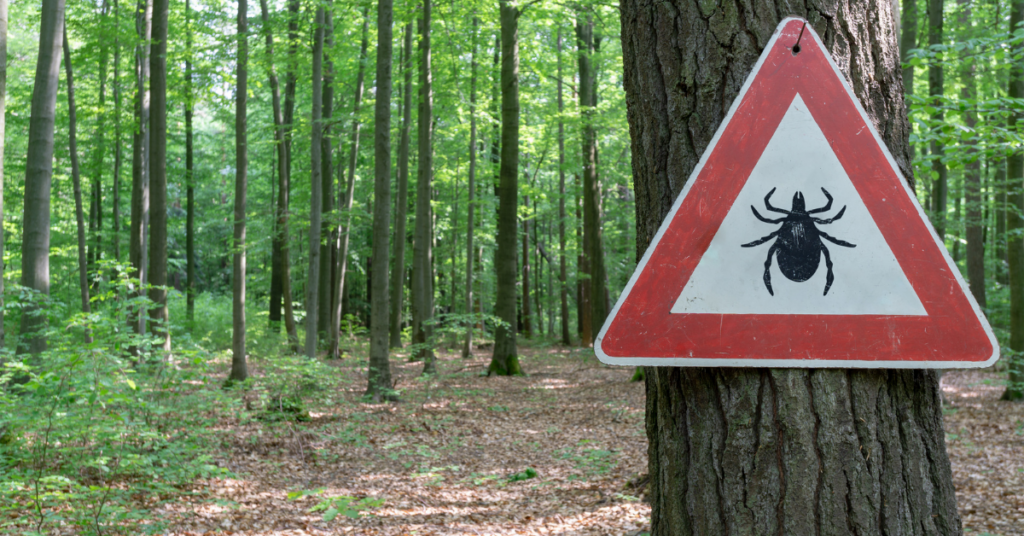If you have ever spent any time in the south during the summer, you quickly learn about three things: humidity, mosquitoes, and ticks. While I am somehow the bug repellant for everyone else (since I’m always the first and worst to be bitten by the mosquitoes), it’s the ticks that really make my skin crawl. I will admit; I have a hard time understanding and explaining why God created these blood sucking creatures. But I think the evolutionists have an even harder time explaining the existence of any parasite, not just the tick or the mosquito.
Some scientific circles do not consider the mosquito to be a parasite since the mosquito doesn’t attach itself to the host. The tick, however, does. Ticks survive by feeding on the blood of mammals, birds, and sometimes amphibians and reptiles. Ticks require blood ingestion from a host in order to grow through its life cycle from egg to larva to nymph to adult.
Even though these parasites are disgusting, they are a fascinating study in biology. And their existence must be explained in some way. Their cephalothorax and abdomen are completely fused into one body segment (compared to the three body segments of an ant and the two body segments of a spider). And they have eight legs. There are two main types of ticks, either hard or soft ticks. Hard ticks have a hard shield on their back and a beak-like structure at the front that contains the mouth parts.
The mouth of the tick is made up of three parts that allow the tick to latch onto its host and feed, and therefore, live. There are two chelicerae which the tick uses to cut through the skin of the host. Then it sticks in the hypostome to latch itself onto the host. The hypostome is a barbed, needle-like structure, where the barb faces backward, making it difficult to pull the tick off of the skin.
The third component to the mouth is the palp. There are two on each side of the tick’s mouth and these simply move out of the way when the tick is feeding. But they play an important role in detecting the tick’s next meal. The palps, along with a unique sensory structure on their legs, are used to detect potential hosts. This sensory structure, known as the Haller’s organ, can detect odors, chemicals, and even infrared light coming off of a potential host. The tick uses these parts to also detect changes in temperature, air currents, moisture, and vibrations so it can attach to a new host.

Ticks are known as obligate hematophages, meaning they require blood to satisfy all of their nutritional requirements. Though ticks can fast for long periods of time, they will eventually die if they are unable to find a host. Once a host is found, some ticks attach to their host immediately. Others will wander around the host to look for thinner skin, like a mammal’s ear.
Depending on the species and life stage of the tick, preparing to feed can take from ten minutes to two hours. Once the tick is ready to feed, it uses the chelicerae to cut into the skin, the hypostome to attach, and then it begins to feed. Once it has become engorged (or completed its meal) it will expand and fall off, where females will then lay their eggs. On average, a tick will need to remain attached to its host for at least 36 to 48 hours to take a complete blood meal. For adult ticks, it can take up to seven days of feeding to become fully engorged.
But the tick, as well as the mosquito, or mite, or any other blood-sucking organism, has a tremendous problem they must overcome. When our bodies are cut and begin to bleed, it activates the blood clotting cascade to form clots and stop the bleeding. If you have read my book, Teaching Others to Defend Christianity, then you are familiar with the blood-clotting cascade and all of the components necessary in order for our bodies to clot blood.
The tick’s cut into the skin triggers the blood clotting Factor X which converts prothrombin into thrombin, which then combines with fibrinogen to begin forming clots. With all of this taking place, the tick won’t be able to ingest fluid blood long enough to complete its meal. It will get a mouthful of blood clots.
So how is the tick able to feed?
Once it has bitten into its host, the tick will inject a protein similar to a blood-thinning drug that blocks factor X and factor V to prevent the blood from clotting. Mosquitoes do the same thing. Their saliva contains an anticoagulant protein called anopheline that inhibits the blood-clotting cascade. So the tick will spit this protein into the host, drink blood for a while, then spit again, to continue the feeding process without the host producing clots.
The tick’s saliva also contains about 1,500 to 3,000 proteins that have anti-inflammatory properties, called evasins, so they can feed undetected by the host for eight to ten days. Researchers are studying both the anti-coagulants and the anti-inflammatory aspects to the tick’s saliva to develop human drugs to help with preventing blood clots, myocarditis, heart attacks, and strokes.
Given all of those amazing features that must be working properly in order for a tick to survive, how did the tick come into existence?
Evolutionists claim the origin of the tick is “uncertain,” yet they think it must have evolved 120 million years ago through “adaptations to blood-feeding.”
But how is an organism going to evolve an adaptation to blood feed, and still survive until they adapt? The process of blood feeding must work in the first generation in order for the tick to survive. The species does not get multiple generations to work out the kinks for feeding. In the case of the tick, the female tick must become engorged from a complete blood feeding in order to drop off the host and lay her eggs. If the blood-feeding process did not work in the first generation, then the female could not lay eggs and there would not be a second generation of ticks (granted, I wouldn’t mind if there hadn’t been a second generation of ticks…).
For the process of macroevolution to work, changes to the organism must be completely random and completely natural. The organism cannot plan for nor anticipate a particular change that would progress the species. Therefore, an adult tick cannot decide it needs an anticoagulant in its spit and make an adaptation to gain that ability to pass on to the next generation.
Furthermore, the mutations cannot be simply a physical adaptation in an adult. For example, if an adult tick was having difficulty latching onto a host so it made some modification to its body to cling on better (of course that violates our first issue stated above about planning for changes), but that physical change will not appear in its offspring. Any changes to the adult phenotype would not be passed down to the next generation. So whatever adaptation or mutation is needed for blood-feeding, it must be a change within the genetic code of the organism.
The assumption within evolution then is that all of the biological and feeding features we see in the tick today could be incrementally built up slowly over time by adding or modifying each feature. That implies that you could remove some of the features of the tick, and the tick would still be functional in some capacity, just maybe not as efficiently.
But the tick’s biological features are not just improvements on a rudimentary blood-feeding method, they are critical features for the success of blood-feeding. In other words, the tick needs all of its features in order to survive at all. Consider just the few ones discussed here. It must have some way of detecting when a host is nearby in order to even have a way to get its next meal. It must then be able to cut into the skin of the host and to latch on so it doesn’t fall off.
Most importantly, the tick needs some way to maintain the flow of blood when it bites. Blind processes of nature would have no way of “knowing” what kind of proteins the tick would need in order to inhibit the blood clotting factors of the host organism. This couldn’t be a trial-and-error type of mutation either. The tick doesn’t have multiple generations of mutating different proteins in its saliva until it finds the right ones. If it didn’t have those proteins in the first place, it couldn’t feed on the host. The first generation of ticks would die off and no future ticks would be around (again, that would not be such a bad thing!).
It begs the question, which one of these features can the tick not have and still survive to reproduce?
The tick needs all of these features in some capacity in order to feed. Now, there are differences in how these features are present depending on the type of tick, but each tick type needs some structure with those capabilities – present in the organism all at the same time and all working together – in order to survive. It could not have slowly acquired these over millions of years of blind, random genetic mutations. Therefore, the tick, though it is a parasite and rather disgusting, is uniquely designed in this way. And design requires a designer.





1 thought on “How Did We Get Stuck with Ticks?”
I don’t understand the intelligent design deniers or the scientific atheist community. Are they able to put each system in a walled room and discuss it as an independent occurrence. In one room is a mammal with a fully functioning blood clotting cascade. In the next room is a tick or other parasite with a fully functioning system that counters the mammals system. Do they never look over the wall? Can these very smart people not see the conflict? Is this scientific cognitive dissonance?
Comments are closed.